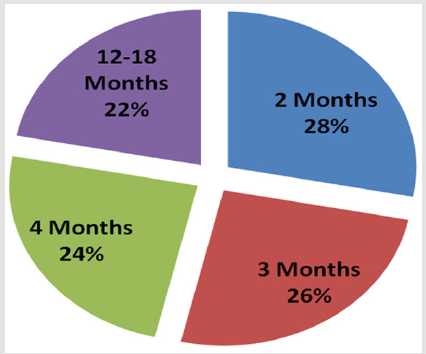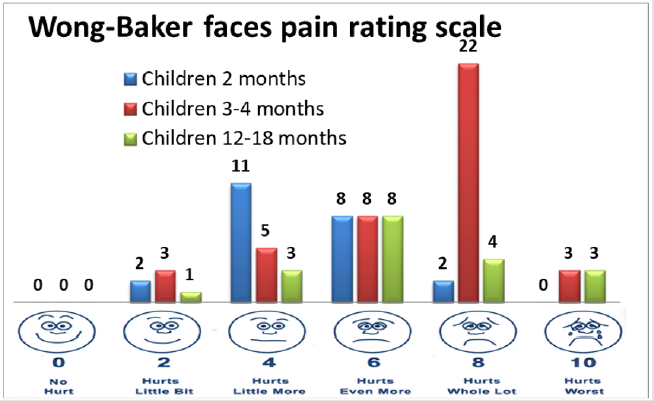Abstract
Introduction: According to the International Association for the Study of Pain “Pain isunpleasant sensory and emotional experience associated with actual or potential tissue damage”Pain is the most common symptom presenting patients in primary care.
Purpose: The purpose of this study isto determine the pain scale in vaccinated children according to age and the size of the induration.
Methodology: The research conducted is a prospective and descriptive type analysis which includes data from January 2019 to June 2019.Determination of pain scale in vaccinated children was done according to the Wong-Baker scale.
Result: The study included 82 randomly selected cases over a 6 month period, starting from January 2019 to June 2019. Of these, 53.65% (44 patients) were female and 46.34% (38 patients) they were men. According to the data collected, it has been concluded that children aged 3-4 months respond more strongly to the vaccine compared to those 2 months old.
Conclusion: Monitoring the scale of pain is difficult, as pain is a subjective experience and can vary from person to person. In our research we can conclude that children aged 3-4 months reacted more during vaccination compared to those who were 2 months old. The children ‘cry’ more during the second vaccine, while in the first one they were more confused and unresponsive.
Keywords: Pain; Vaccination; Children
Introduction
According to the International Association for the Study of Pain (IASP) ‘’Pain isan unpleasant sensory and emotional experience associated with actual or potential tissue damage. Pain is the most common symptom presenting patients in primary care [1]. Pain occurs when the tissues are being damaged, and forces the personto react to remove the pain stimuli. Monitoring the scale of pain is difficult, as pain is a subjective experience and can vary from person to person. Failure to assess pain can affect quality of life and lead to increased hospitalization days [2].
The purpose
The purpose of this study is to determine the pain scale in vaccinated children, according to the mimicry - Wong-Baker Scale and determination of pain scaleby age, vaccine type and induration size. During treating health problems in primary health care, pain is the most commonly encountered symptom, which despite the rapid development of diagnostics and medical technology, still remains undiagnosed and not well treated. Therefore, it is of utmost importance to adopt pain assessment methods to achieve the most effective treatment of pain and its causes.
Methodology and Material
The research is a prospective type analysis, descriptive-type, that includes data from January 2019 to June 2019. Determination of scale pain in vaccinated children was done according to the Wong-Baker scale.Data presentation was done using charts and graphs. The analytical and comparative statistical method was used. The total number of patients was divided by sex, age, size of skin induration after vaccination, and manifestation of pain during vaccination. The research data were obtained from the Main Family Medicine Center in Gjilan [3-5].
Results
The research includes 82 randomly selected cases over a period of 6 months, starting from 1st of January 2019 to 30 of June 2019. Of these, 53.65% (44 children) were female and 46.34% (38 children) were male(Table 1) (Figure 1). During this period in MFMC in Gjilan, 82 children were vaccinated, of which 23 cases (28.04%) were 2 months of age, 21 cases (25.60%) 3 months, 20 cases (24.39%) 4 months and 18 cases (21, 95%) were 12-18 months(Table 2) (Figure 2). According to the size of skin induration after vaccination, 31 (37.80%) children responded with 3mm induration, 17 (20.73%) children with 5mm induration, 19 (23.17%) with 4mm induration, 9 (10.97%) with induration 2 mm, and 4 (4.87%) of children after vaccination did not have skin induration(Table 3) (Figure 3). According to the data collected, it has been concluded that children aged 3-4 months respond more strongly to the vaccine compared to those 2 months old. Also, children cry more when they receive the second vaccine, while they are confused and unresponsive during the first vaccine (Figure 4).
Discussion and Conclusion
Monitoring the degree of pain is difficult, as pain is a subjective experience and can vary from person to person. Of the total number of 82 children surveyed, 18% responded with a pain scale 4; 35% responded with pain scale 6, 9% of them responded with a scale of pain 8, and 8% of them with a scale of pain 2. That means children of age 3-4 months respond more strongly to the vaccine compared to those 2 months old. The children cry more during the second vaccine, while in the first one they were more confused and unresponsive.According to a study conducted in Canada by the Medical Research Council of Canada, a sample of 87 children found that ages 3 to 5 months manifest more pain during vaccination. It is worth noting that the two comparative studies used a common methodology such as the Wong-Baker mimicry scale and the VAS (Visual Analoug Scale) [6,7].
References
- Karen Koch (2014) Assessing pain in primary care. Official journal of the South African Academy of Family Practice/Primary Care 54(1): 21-24.
- Pathophysiology of the third, renewed and supplemented, Stjepan Gamulin, Marushiq Matko, Sllavko Kërvavicaiz 375.
- Khalid W Al Quliti, Majed S Alamri (2015) Assessment of pain Knowledge, attitudes, and practices of health care providers in AlmadinahAlmunawwarah, Saudi Arabia. Neurosciences 20(2): 131-136.
- https://www.dreamstime.com/stock-illustration-nerve-response-to-pain-touch-noxious-receptors-skin-pathway-brain-via-spinal- cord-thalamus-image56635420.
- Dual Pathways for Transmission of Pain Signals into the Central Nervous System. Medical Physiology.
- Sabu James (2013) Human pain and genetics: some basics. Br J Pain 7(4): 171-178.
- Ludger Klimek, Karl Christian Bergmann, Tilo Biedermann, Jean Bousquet, Peter Hellings, et al. (2017) Visual analogue scales (VAS): Measuring instruments for the documentation of symptoms and therapy monitoring in cases of allergic rhinitis in everyday health care. Allergo J Int 26(1): 16-24.

 Research Article
Research Article






